Risk Register and Risk Map
VerifiedAdded on 2023/04/21
|9
|1823
|430
AI Summary
This document provides a risk register and risk map for a mining company, outlining various workplace risks and ways to manage them. It also discusses the importance of treating risks effectively to reduce their impact on the organization.
Contribute Materials
Your contribution can guide someone’s learning journey. Share your
documents today.
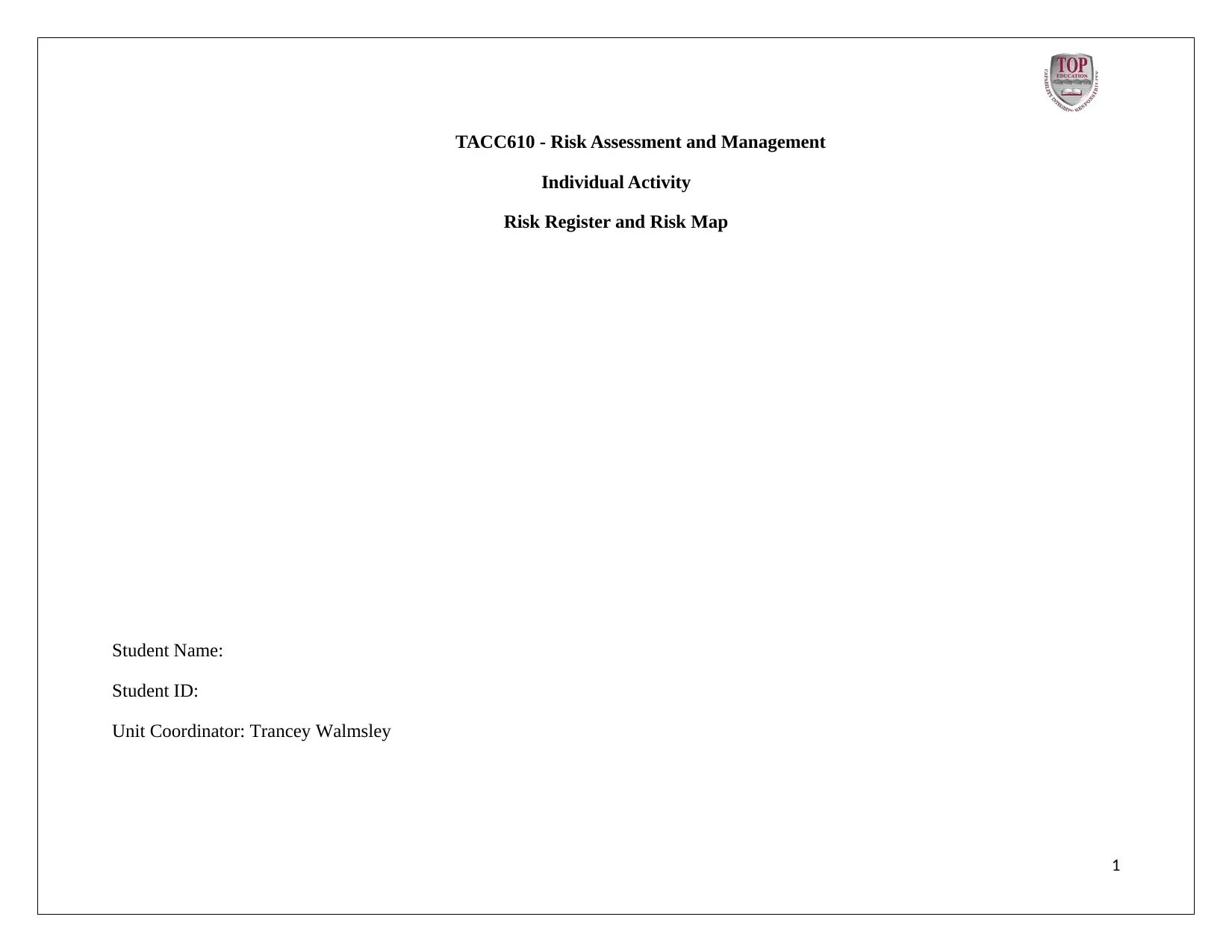
TACC610 - Risk Assessment and Management
Individual Activity
Risk Register and Risk Map
Student Name:
Student ID:
Unit Coordinator: Trancey Walmsley
1
Individual Activity
Risk Register and Risk Map
Student Name:
Student ID:
Unit Coordinator: Trancey Walmsley
1
Secure Best Marks with AI Grader
Need help grading? Try our AI Grader for instant feedback on your assignments.
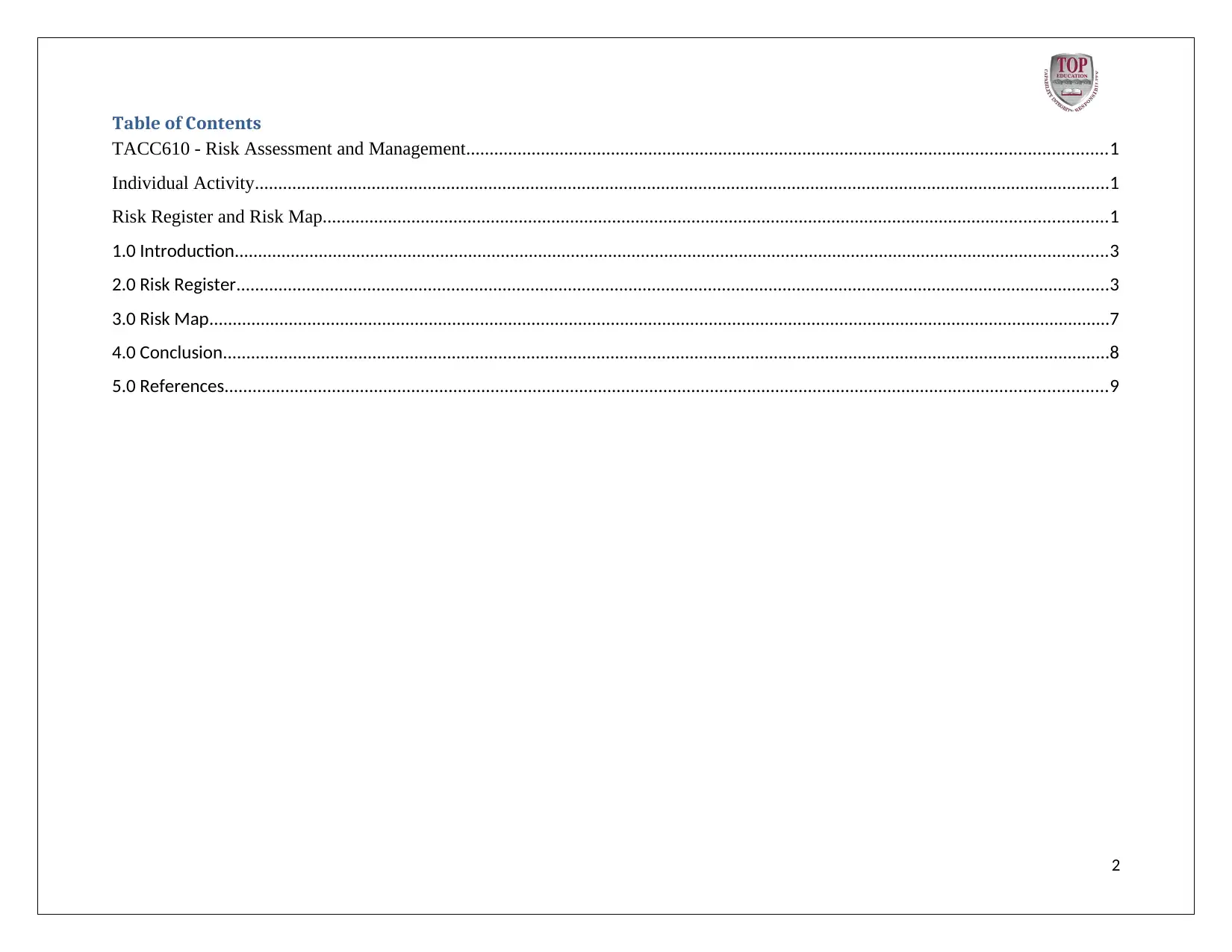
Table of Contents
TACC610 - Risk Assessment and Management.........................................................................................................................................1
Individual Activity.......................................................................................................................................................................................1
Risk Register and Risk Map........................................................................................................................................................................1
1.0 Introduction...........................................................................................................................................................................................3
2.0 Risk Register...........................................................................................................................................................................................3
3.0 Risk Map.................................................................................................................................................................................................7
4.0 Conclusion..............................................................................................................................................................................................8
5.0 References.............................................................................................................................................................................................9
2
TACC610 - Risk Assessment and Management.........................................................................................................................................1
Individual Activity.......................................................................................................................................................................................1
Risk Register and Risk Map........................................................................................................................................................................1
1.0 Introduction...........................................................................................................................................................................................3
2.0 Risk Register...........................................................................................................................................................................................3
3.0 Risk Map.................................................................................................................................................................................................7
4.0 Conclusion..............................................................................................................................................................................................8
5.0 References.............................................................................................................................................................................................9
2

1.0 Introduction
A business requires its activities to be mapped and aspects of contingencies to be covered (Howes et al, 2015). In every organisation,
especially in mining companies, all possible workplace risks need to be covered. In the current discussion a risk register for a mining
company has been developed. The risk register encompasses various possibilities of workplace risks occurring along with their
possibilities of occurrence and ways to deal with them (Loosemore, Raftery, Reilly & Higgon, 2012). Taking into consideration the
varied types of risks a comprehensive risk map has been constructed to understand their possible impacts against likelihood of
occurrence.
2.0 Risk Register
A risk register for variety of risks occurring at the mining company has been included below along with ways to manage them (Kable,
Guest & McLeod, 2011).
Outline of
risks
Do
cu
me
nt
Co
ntr
ol
Inf
or
ma
tio
n
Risk
Identifier
Risk
Catego
ry
Likeliho
od of
risk
Impact of
risk
Risk
Response
Category
Owner of
the Risk
Risk
Respo
nse
Action
Due
Dat
e of
Co
mpl
etin
g
Acti
on
Monitoring & Review
Details of
Monitorin
g Activity
Freque
ncy of
Monito
ring
Responsi
ble
Manager
for
monitori
ng
1. Noise ISO
900
1
Noise level
exceeding
90dB (Bahn,
2013)
Employ
ee
related.
Employ
ees who
are
High,
employe
es
working
at mining
sites is
High,
employees
might end
up losing
hearing
capability
Mitigate by
installing
sound
regulators on
machines
Mining
site
Engineer
&
Manager
Mr. X.
Reduc
e Risk
6
mon
ths
fro
m
date
Initiate
installation
of sound,
especially
noise
control
Twice
in a
month
Senior
Engineer
at
Mining
Site Mr.
Y. Chu
3
A business requires its activities to be mapped and aspects of contingencies to be covered (Howes et al, 2015). In every organisation,
especially in mining companies, all possible workplace risks need to be covered. In the current discussion a risk register for a mining
company has been developed. The risk register encompasses various possibilities of workplace risks occurring along with their
possibilities of occurrence and ways to deal with them (Loosemore, Raftery, Reilly & Higgon, 2012). Taking into consideration the
varied types of risks a comprehensive risk map has been constructed to understand their possible impacts against likelihood of
occurrence.
2.0 Risk Register
A risk register for variety of risks occurring at the mining company has been included below along with ways to manage them (Kable,
Guest & McLeod, 2011).
Outline of
risks
Do
cu
me
nt
Co
ntr
ol
Inf
or
ma
tio
n
Risk
Identifier
Risk
Catego
ry
Likeliho
od of
risk
Impact of
risk
Risk
Response
Category
Owner of
the Risk
Risk
Respo
nse
Action
Due
Dat
e of
Co
mpl
etin
g
Acti
on
Monitoring & Review
Details of
Monitorin
g Activity
Freque
ncy of
Monito
ring
Responsi
ble
Manager
for
monitori
ng
1. Noise ISO
900
1
Noise level
exceeding
90dB (Bahn,
2013)
Employ
ee
related.
Employ
ees who
are
High,
employe
es
working
at mining
sites is
High,
employees
might end
up losing
hearing
capability
Mitigate by
installing
sound
regulators on
machines
Mining
site
Engineer
&
Manager
Mr. X.
Reduc
e Risk
6
mon
ths
fro
m
date
Initiate
installation
of sound,
especially
noise
control
Twice
in a
month
Senior
Engineer
at
Mining
Site Mr.
Y. Chu
3
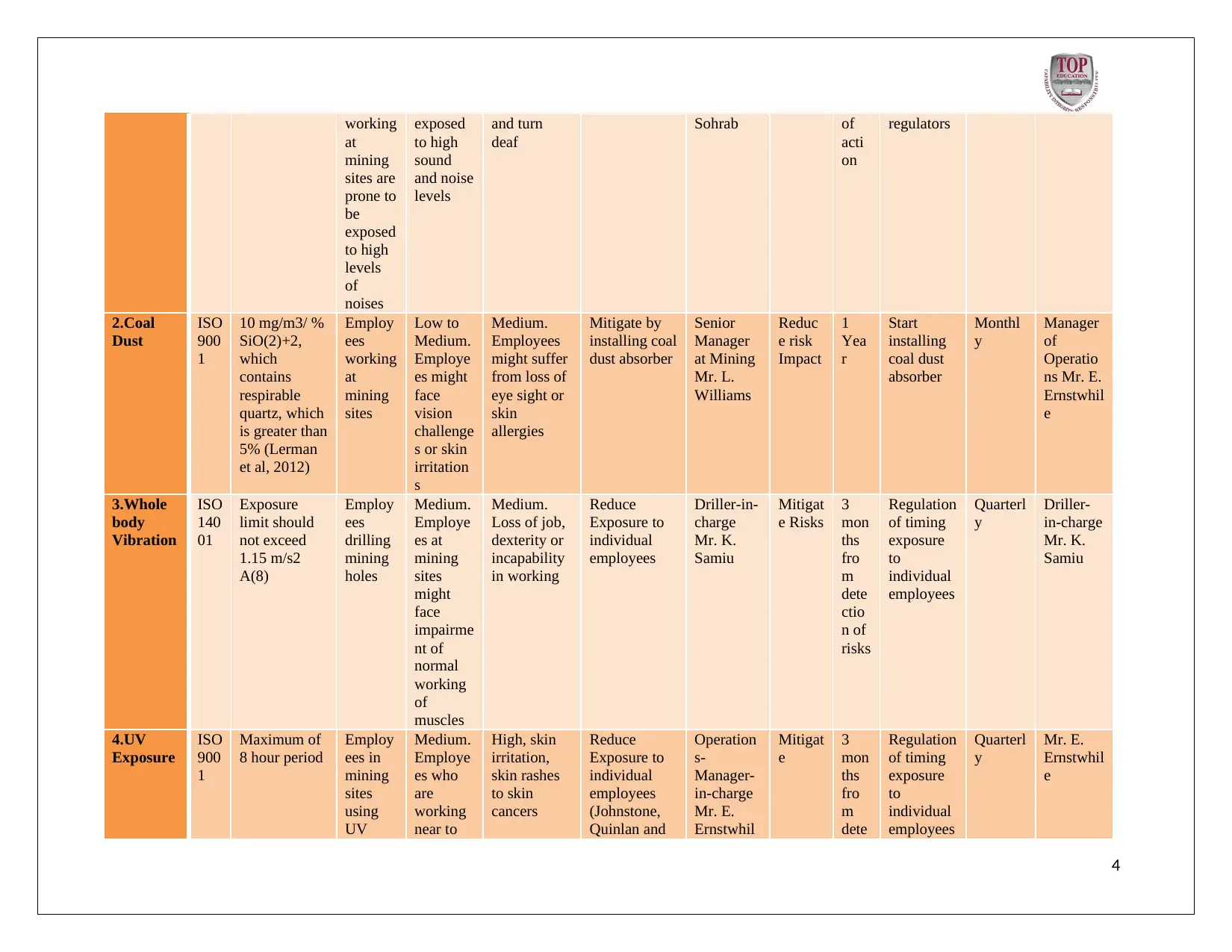
working
at
mining
sites are
prone to
be
exposed
to high
levels
of
noises
exposed
to high
sound
and noise
levels
and turn
deaf
Sohrab of
acti
on
regulators
2.Coal
Dust
ISO
900
1
10 mg/m3/ %
SiO(2)+2,
which
contains
respirable
quartz, which
is greater than
5% (Lerman
et al, 2012)
Employ
ees
working
at
mining
sites
Low to
Medium.
Employe
es might
face
vision
challenge
s or skin
irritation
s
Medium.
Employees
might suffer
from loss of
eye sight or
skin
allergies
Mitigate by
installing coal
dust absorber
Senior
Manager
at Mining
Mr. L.
Williams
Reduc
e risk
Impact
1
Yea
r
Start
installing
coal dust
absorber
Monthl
y
Manager
of
Operatio
ns Mr. E.
Ernstwhil
e
3.Whole
body
Vibration
ISO
140
01
Exposure
limit should
not exceed
1.15 m/s2
A(8)
Employ
ees
drilling
mining
holes
Medium.
Employe
es at
mining
sites
might
face
impairme
nt of
normal
working
of
muscles
Medium.
Loss of job,
dexterity or
incapability
in working
Reduce
Exposure to
individual
employees
Driller-in-
charge
Mr. K.
Samiu
Mitigat
e Risks
3
mon
ths
fro
m
dete
ctio
n of
risks
Regulation
of timing
exposure
to
individual
employees
Quarterl
y
Driller-
in-charge
Mr. K.
Samiu
4.UV
Exposure
ISO
900
1
Maximum of
8 hour period
Employ
ees in
mining
sites
using
UV
Medium.
Employe
es who
are
working
near to
High, skin
irritation,
skin rashes
to skin
cancers
Reduce
Exposure to
individual
employees
(Johnstone,
Quinlan and
Operation
s-
Manager-
in-charge
Mr. E.
Ernstwhil
Mitigat
e
3
mon
ths
fro
m
dete
Regulation
of timing
exposure
to
individual
employees
Quarterl
y
Mr. E.
Ernstwhil
e
4
at
mining
sites are
prone to
be
exposed
to high
levels
of
noises
exposed
to high
sound
and noise
levels
and turn
deaf
Sohrab of
acti
on
regulators
2.Coal
Dust
ISO
900
1
10 mg/m3/ %
SiO(2)+2,
which
contains
respirable
quartz, which
is greater than
5% (Lerman
et al, 2012)
Employ
ees
working
at
mining
sites
Low to
Medium.
Employe
es might
face
vision
challenge
s or skin
irritation
s
Medium.
Employees
might suffer
from loss of
eye sight or
skin
allergies
Mitigate by
installing coal
dust absorber
Senior
Manager
at Mining
Mr. L.
Williams
Reduc
e risk
Impact
1
Yea
r
Start
installing
coal dust
absorber
Monthl
y
Manager
of
Operatio
ns Mr. E.
Ernstwhil
e
3.Whole
body
Vibration
ISO
140
01
Exposure
limit should
not exceed
1.15 m/s2
A(8)
Employ
ees
drilling
mining
holes
Medium.
Employe
es at
mining
sites
might
face
impairme
nt of
normal
working
of
muscles
Medium.
Loss of job,
dexterity or
incapability
in working
Reduce
Exposure to
individual
employees
Driller-in-
charge
Mr. K.
Samiu
Mitigat
e Risks
3
mon
ths
fro
m
dete
ctio
n of
risks
Regulation
of timing
exposure
to
individual
employees
Quarterl
y
Driller-
in-charge
Mr. K.
Samiu
4.UV
Exposure
ISO
900
1
Maximum of
8 hour period
Employ
ees in
mining
sites
using
UV
Medium.
Employe
es who
are
working
near to
High, skin
irritation,
skin rashes
to skin
cancers
Reduce
Exposure to
individual
employees
(Johnstone,
Quinlan and
Operation
s-
Manager-
in-charge
Mr. E.
Ernstwhil
Mitigat
e
3
mon
ths
fro
m
dete
Regulation
of timing
exposure
to
individual
employees
Quarterl
y
Mr. E.
Ernstwhil
e
4
Paraphrase This Document
Need a fresh take? Get an instant paraphrase of this document with our AI Paraphraser
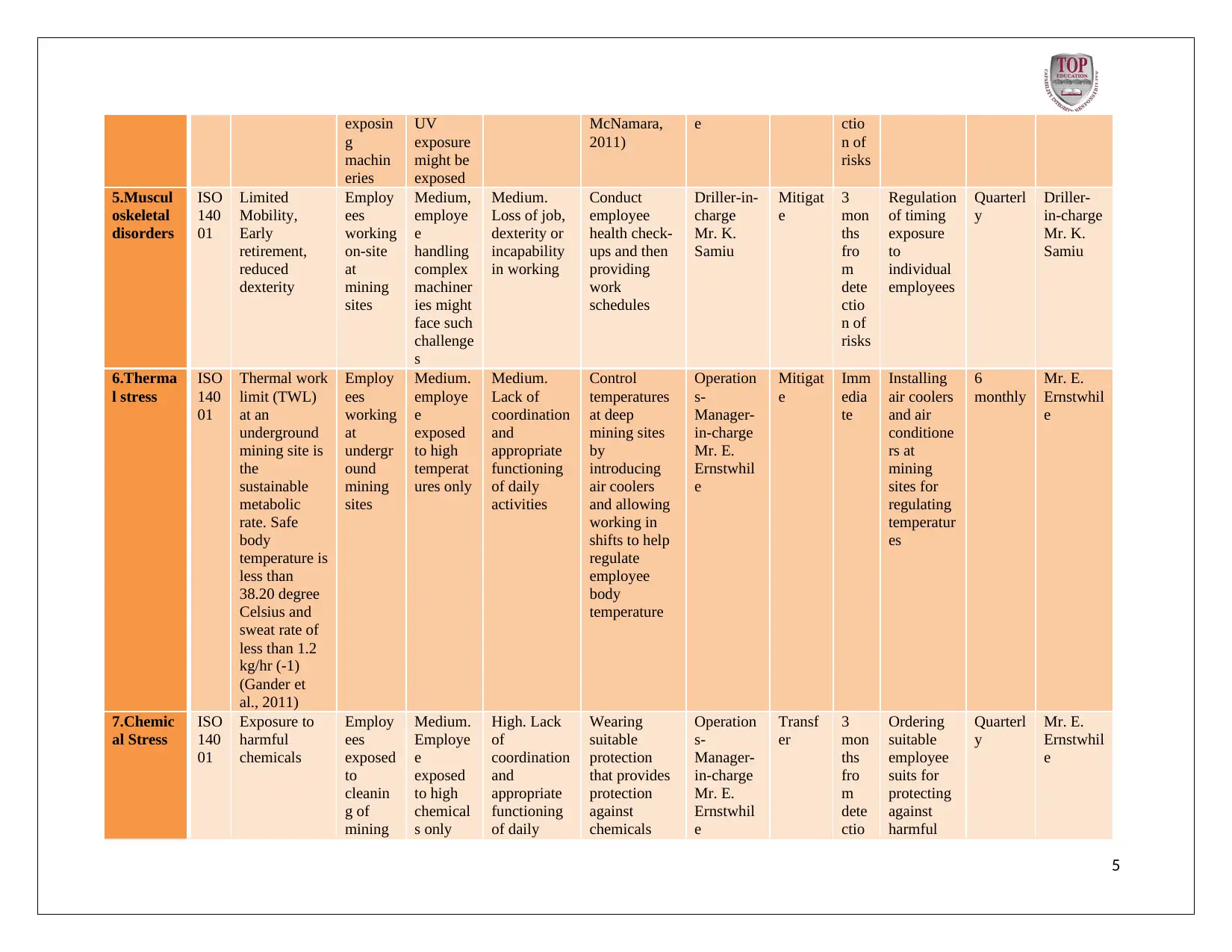
exposin
g
machin
eries
UV
exposure
might be
exposed
McNamara,
2011)
e ctio
n of
risks
5.Muscul
oskeletal
disorders
ISO
140
01
Limited
Mobility,
Early
retirement,
reduced
dexterity
Employ
ees
working
on-site
at
mining
sites
Medium,
employe
e
handling
complex
machiner
ies might
face such
challenge
s
Medium.
Loss of job,
dexterity or
incapability
in working
Conduct
employee
health check-
ups and then
providing
work
schedules
Driller-in-
charge
Mr. K.
Samiu
Mitigat
e
3
mon
ths
fro
m
dete
ctio
n of
risks
Regulation
of timing
exposure
to
individual
employees
Quarterl
y
Driller-
in-charge
Mr. K.
Samiu
6.Therma
l stress
ISO
140
01
Thermal work
limit (TWL)
at an
underground
mining site is
the
sustainable
metabolic
rate. Safe
body
temperature is
less than
38.20 degree
Celsius and
sweat rate of
less than 1.2
kg/hr (-1)
(Gander et
al., 2011)
Employ
ees
working
at
undergr
ound
mining
sites
Medium.
employe
e
exposed
to high
temperat
ures only
Medium.
Lack of
coordination
and
appropriate
functioning
of daily
activities
Control
temperatures
at deep
mining sites
by
introducing
air coolers
and allowing
working in
shifts to help
regulate
employee
body
temperature
Operation
s-
Manager-
in-charge
Mr. E.
Ernstwhil
e
Mitigat
e
Imm
edia
te
Installing
air coolers
and air
conditione
rs at
mining
sites for
regulating
temperatur
es
6
monthly
Mr. E.
Ernstwhil
e
7.Chemic
al Stress
ISO
140
01
Exposure to
harmful
chemicals
Employ
ees
exposed
to
cleanin
g of
mining
Medium.
Employe
e
exposed
to high
chemical
s only
High. Lack
of
coordination
and
appropriate
functioning
of daily
Wearing
suitable
protection
that provides
protection
against
chemicals
Operation
s-
Manager-
in-charge
Mr. E.
Ernstwhil
e
Transf
er
3
mon
ths
fro
m
dete
ctio
Ordering
suitable
employee
suits for
protecting
against
harmful
Quarterl
y
Mr. E.
Ernstwhil
e
5
g
machin
eries
UV
exposure
might be
exposed
McNamara,
2011)
e ctio
n of
risks
5.Muscul
oskeletal
disorders
ISO
140
01
Limited
Mobility,
Early
retirement,
reduced
dexterity
Employ
ees
working
on-site
at
mining
sites
Medium,
employe
e
handling
complex
machiner
ies might
face such
challenge
s
Medium.
Loss of job,
dexterity or
incapability
in working
Conduct
employee
health check-
ups and then
providing
work
schedules
Driller-in-
charge
Mr. K.
Samiu
Mitigat
e
3
mon
ths
fro
m
dete
ctio
n of
risks
Regulation
of timing
exposure
to
individual
employees
Quarterl
y
Driller-
in-charge
Mr. K.
Samiu
6.Therma
l stress
ISO
140
01
Thermal work
limit (TWL)
at an
underground
mining site is
the
sustainable
metabolic
rate. Safe
body
temperature is
less than
38.20 degree
Celsius and
sweat rate of
less than 1.2
kg/hr (-1)
(Gander et
al., 2011)
Employ
ees
working
at
undergr
ound
mining
sites
Medium.
employe
e
exposed
to high
temperat
ures only
Medium.
Lack of
coordination
and
appropriate
functioning
of daily
activities
Control
temperatures
at deep
mining sites
by
introducing
air coolers
and allowing
working in
shifts to help
regulate
employee
body
temperature
Operation
s-
Manager-
in-charge
Mr. E.
Ernstwhil
e
Mitigat
e
Imm
edia
te
Installing
air coolers
and air
conditione
rs at
mining
sites for
regulating
temperatur
es
6
monthly
Mr. E.
Ernstwhil
e
7.Chemic
al Stress
ISO
140
01
Exposure to
harmful
chemicals
Employ
ees
exposed
to
cleanin
g of
mining
Medium.
Employe
e
exposed
to high
chemical
s only
High. Lack
of
coordination
and
appropriate
functioning
of daily
Wearing
suitable
protection
that provides
protection
against
chemicals
Operation
s-
Manager-
in-charge
Mr. E.
Ernstwhil
e
Transf
er
3
mon
ths
fro
m
dete
ctio
Ordering
suitable
employee
suits for
protecting
against
harmful
Quarterl
y
Mr. E.
Ernstwhil
e
5
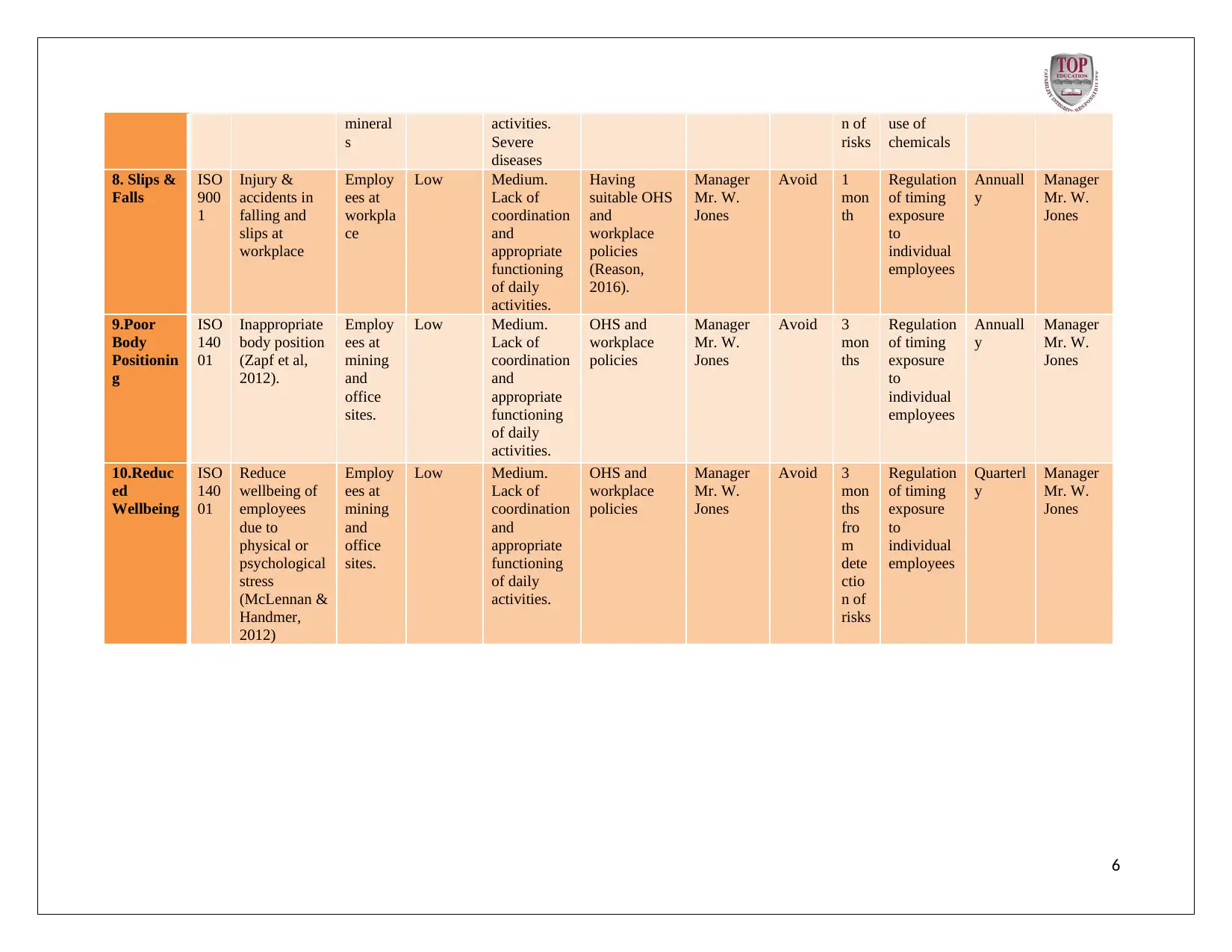
mineral
s
activities.
Severe
diseases
n of
risks
use of
chemicals
8. Slips &
Falls
ISO
900
1
Injury &
accidents in
falling and
slips at
workplace
Employ
ees at
workpla
ce
Low Medium.
Lack of
coordination
and
appropriate
functioning
of daily
activities.
Having
suitable OHS
and
workplace
policies
(Reason,
2016).
Manager
Mr. W.
Jones
Avoid 1
mon
th
Regulation
of timing
exposure
to
individual
employees
Annuall
y
Manager
Mr. W.
Jones
9.Poor
Body
Positionin
g
ISO
140
01
Inappropriate
body position
(Zapf et al,
2012).
Employ
ees at
mining
and
office
sites.
Low Medium.
Lack of
coordination
and
appropriate
functioning
of daily
activities.
OHS and
workplace
policies
Manager
Mr. W.
Jones
Avoid 3
mon
ths
Regulation
of timing
exposure
to
individual
employees
Annuall
y
Manager
Mr. W.
Jones
10.Reduc
ed
Wellbeing
ISO
140
01
Reduce
wellbeing of
employees
due to
physical or
psychological
stress
(McLennan &
Handmer,
2012)
Employ
ees at
mining
and
office
sites.
Low Medium.
Lack of
coordination
and
appropriate
functioning
of daily
activities.
OHS and
workplace
policies
Manager
Mr. W.
Jones
Avoid 3
mon
ths
fro
m
dete
ctio
n of
risks
Regulation
of timing
exposure
to
individual
employees
Quarterl
y
Manager
Mr. W.
Jones
6
s
activities.
Severe
diseases
n of
risks
use of
chemicals
8. Slips &
Falls
ISO
900
1
Injury &
accidents in
falling and
slips at
workplace
Employ
ees at
workpla
ce
Low Medium.
Lack of
coordination
and
appropriate
functioning
of daily
activities.
Having
suitable OHS
and
workplace
policies
(Reason,
2016).
Manager
Mr. W.
Jones
Avoid 1
mon
th
Regulation
of timing
exposure
to
individual
employees
Annuall
y
Manager
Mr. W.
Jones
9.Poor
Body
Positionin
g
ISO
140
01
Inappropriate
body position
(Zapf et al,
2012).
Employ
ees at
mining
and
office
sites.
Low Medium.
Lack of
coordination
and
appropriate
functioning
of daily
activities.
OHS and
workplace
policies
Manager
Mr. W.
Jones
Avoid 3
mon
ths
Regulation
of timing
exposure
to
individual
employees
Annuall
y
Manager
Mr. W.
Jones
10.Reduc
ed
Wellbeing
ISO
140
01
Reduce
wellbeing of
employees
due to
physical or
psychological
stress
(McLennan &
Handmer,
2012)
Employ
ees at
mining
and
office
sites.
Low Medium.
Lack of
coordination
and
appropriate
functioning
of daily
activities.
OHS and
workplace
policies
Manager
Mr. W.
Jones
Avoid 3
mon
ths
fro
m
dete
ctio
n of
risks
Regulation
of timing
exposure
to
individual
employees
Quarterl
y
Manager
Mr. W.
Jones
6
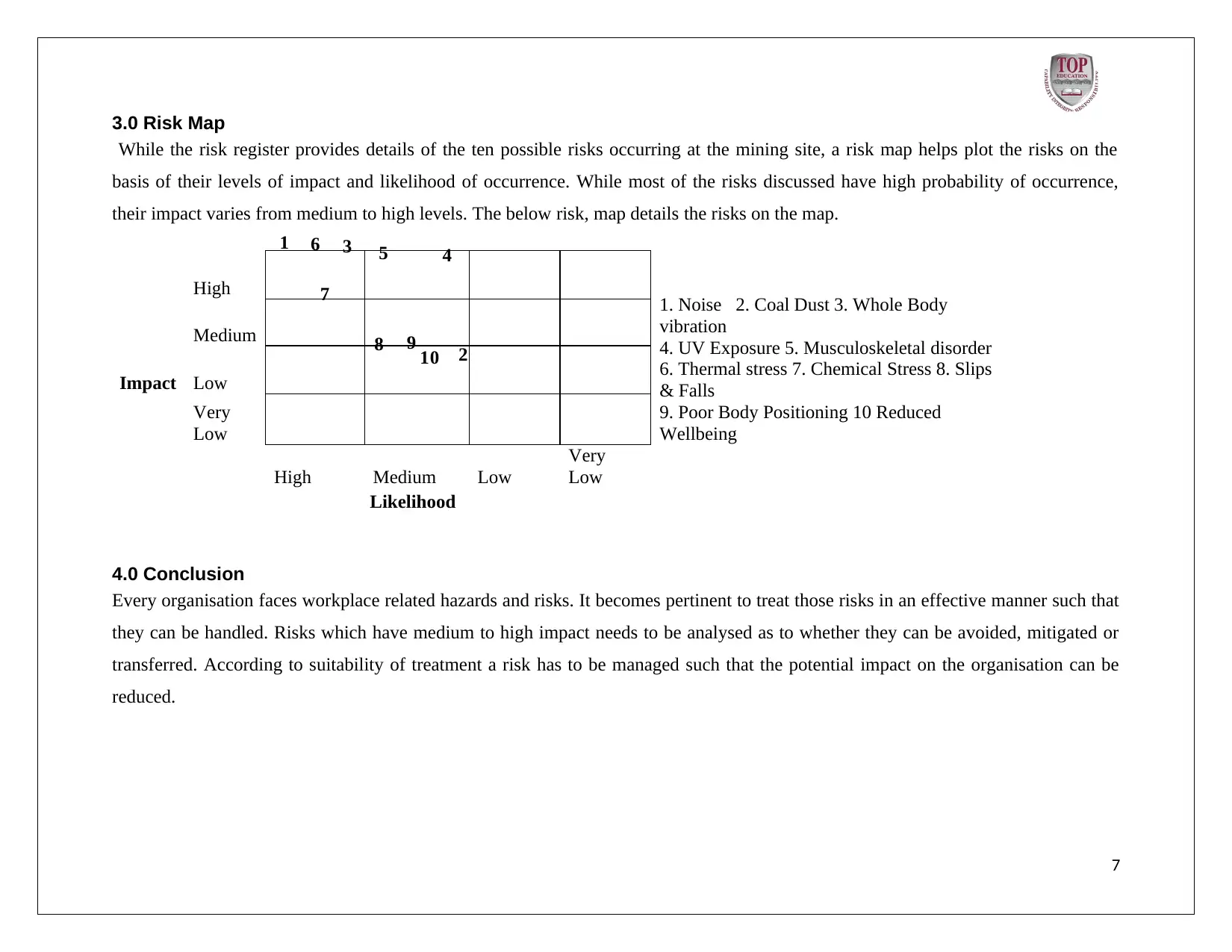
3.0 Risk Map
While the risk register provides details of the ten possible risks occurring at the mining site, a risk map helps plot the risks on the
basis of their levels of impact and likelihood of occurrence. While most of the risks discussed have high probability of occurrence,
their impact varies from medium to high levels. The below risk, map details the risks on the map.
High 1. Noise 2. Coal Dust 3. Whole Body
vibration
4. UV Exposure 5. Musculoskeletal disorder
6. Thermal stress 7. Chemical Stress 8. Slips
& Falls
9. Poor Body Positioning 10 Reduced
Wellbeing
Medium
Impact Low
Very
Low
High Medium Low
Very
Low
Likelihood
4.0 Conclusion
Every organisation faces workplace related hazards and risks. It becomes pertinent to treat those risks in an effective manner such that
they can be handled. Risks which have medium to high impact needs to be analysed as to whether they can be avoided, mitigated or
transferred. According to suitability of treatment a risk has to be managed such that the potential impact on the organisation can be
reduced.
7
1
2
3 456
7
8 9 10
While the risk register provides details of the ten possible risks occurring at the mining site, a risk map helps plot the risks on the
basis of their levels of impact and likelihood of occurrence. While most of the risks discussed have high probability of occurrence,
their impact varies from medium to high levels. The below risk, map details the risks on the map.
High 1. Noise 2. Coal Dust 3. Whole Body
vibration
4. UV Exposure 5. Musculoskeletal disorder
6. Thermal stress 7. Chemical Stress 8. Slips
& Falls
9. Poor Body Positioning 10 Reduced
Wellbeing
Medium
Impact Low
Very
Low
High Medium Low
Very
Low
Likelihood
4.0 Conclusion
Every organisation faces workplace related hazards and risks. It becomes pertinent to treat those risks in an effective manner such that
they can be handled. Risks which have medium to high impact needs to be analysed as to whether they can be avoided, mitigated or
transferred. According to suitability of treatment a risk has to be managed such that the potential impact on the organisation can be
reduced.
7
1
2
3 456
7
8 9 10
Secure Best Marks with AI Grader
Need help grading? Try our AI Grader for instant feedback on your assignments.

5.0 References
Bahn, S., 2013. Workplace hazard identification and management: The case of an underground mining operation. Safety science, 57,
pp.129-137.
Gander, P., Hartley, L., Powell, D., Cabon, P., Hitchcock, E., Mills, A. and Popkin, S., 2011. Fatigue risk management: Organizational
factors at the regulatory and industry/company level. Accident Analysis & Prevention, 43(2), pp.573-590.
Howes, M., Tangney, P., Reis, K., Grant-Smith, D., Heazle, M., Bosomworth, K. and Burton, P., 2015. Towards networked
governance: Improving interagency communication and collaboration for disaster risk management and climate change adaptation in
Australia. Journal of environmental planning and management, 58(5), pp.757-776.
Johnstone, R., Quinlan, M. and McNamara, M., 2011. OHS inspectors and psychosocial risk factors: Evidence from Australia. Safety
Science, 49(4), pp.547-557.
Kable, A.K., Guest, M. and McLeod, M., 2011. Organizational risk management and nurses' perceptions of workplace risk associated
with sharps including needlestick injuries in nurses in New South Wales, Australia. Nursing & health sciences, 13(3), pp.246-254.
Lerman, S.E., Eskin, E., Flower, D.J., George, E.C., Gerson, B., Hartenbaum, N., Hursh, S.R. and Moore-Ede, M., 2012. Fatigue risk
management in the workplace. Journal of Occupational and Environmental Medicine, 54(2), pp.231-258.
Loosemore, M., Raftery, J., Reilly, C. and Higgon, D., 2012. Risk management in projects. Routledge.
McLennan, B.J. and Handmer, J., 2012. Reframing responsibility-sharing for bushfire risk management in Australia after Black
Saturday. Environmental Hazards, 11(1), pp.1-15.
Reason, J., 2016. Managing the risks of organizational accidents. Routledge.
8
Bahn, S., 2013. Workplace hazard identification and management: The case of an underground mining operation. Safety science, 57,
pp.129-137.
Gander, P., Hartley, L., Powell, D., Cabon, P., Hitchcock, E., Mills, A. and Popkin, S., 2011. Fatigue risk management: Organizational
factors at the regulatory and industry/company level. Accident Analysis & Prevention, 43(2), pp.573-590.
Howes, M., Tangney, P., Reis, K., Grant-Smith, D., Heazle, M., Bosomworth, K. and Burton, P., 2015. Towards networked
governance: Improving interagency communication and collaboration for disaster risk management and climate change adaptation in
Australia. Journal of environmental planning and management, 58(5), pp.757-776.
Johnstone, R., Quinlan, M. and McNamara, M., 2011. OHS inspectors and psychosocial risk factors: Evidence from Australia. Safety
Science, 49(4), pp.547-557.
Kable, A.K., Guest, M. and McLeod, M., 2011. Organizational risk management and nurses' perceptions of workplace risk associated
with sharps including needlestick injuries in nurses in New South Wales, Australia. Nursing & health sciences, 13(3), pp.246-254.
Lerman, S.E., Eskin, E., Flower, D.J., George, E.C., Gerson, B., Hartenbaum, N., Hursh, S.R. and Moore-Ede, M., 2012. Fatigue risk
management in the workplace. Journal of Occupational and Environmental Medicine, 54(2), pp.231-258.
Loosemore, M., Raftery, J., Reilly, C. and Higgon, D., 2012. Risk management in projects. Routledge.
McLennan, B.J. and Handmer, J., 2012. Reframing responsibility-sharing for bushfire risk management in Australia after Black
Saturday. Environmental Hazards, 11(1), pp.1-15.
Reason, J., 2016. Managing the risks of organizational accidents. Routledge.
8
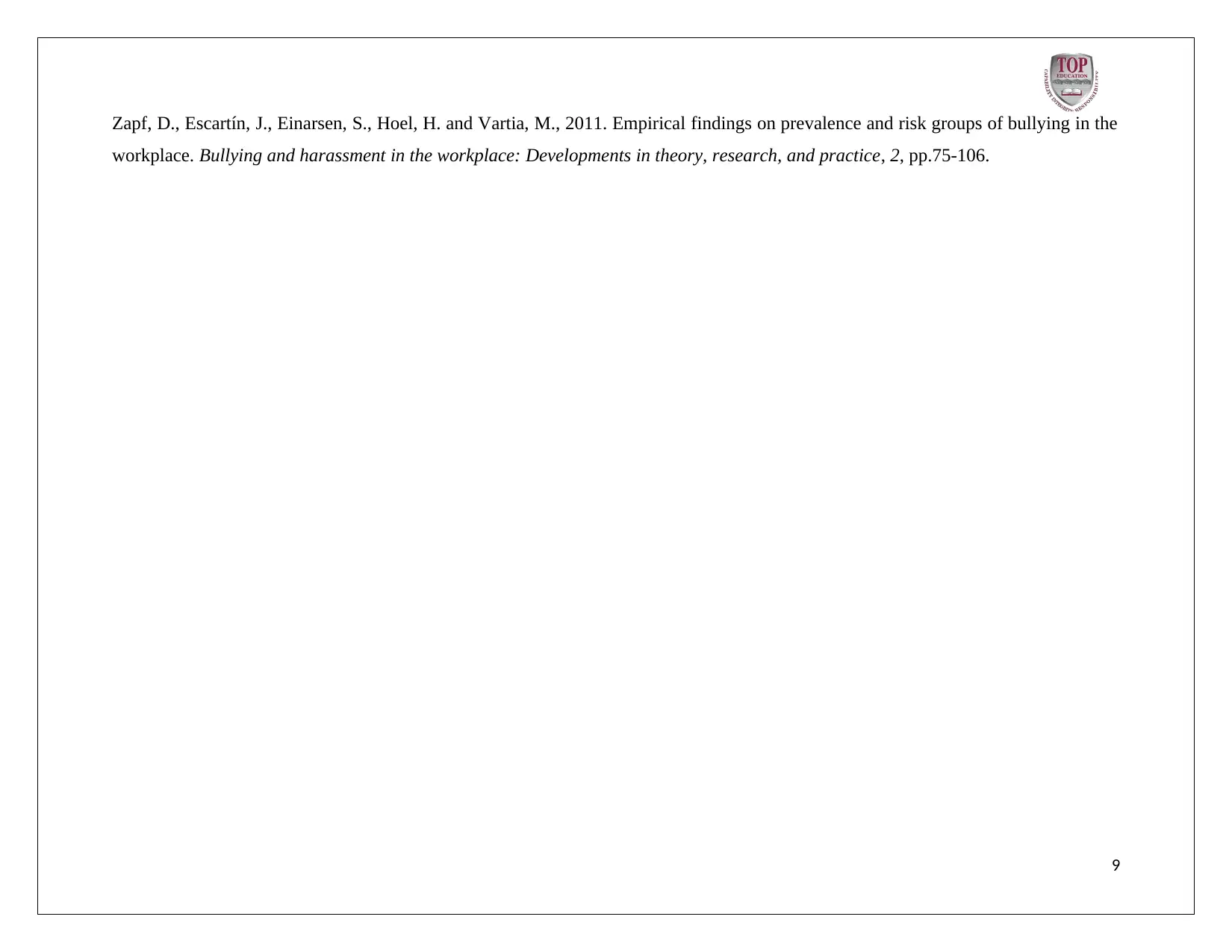
Zapf, D., Escartín, J., Einarsen, S., Hoel, H. and Vartia, M., 2011. Empirical findings on prevalence and risk groups of bullying in the
workplace. Bullying and harassment in the workplace: Developments in theory, research, and practice, 2, pp.75-106.
9
workplace. Bullying and harassment in the workplace: Developments in theory, research, and practice, 2, pp.75-106.
9
1 out of 9
![[object Object]](/_next/static/media/star-bottom.7253800d.svg)